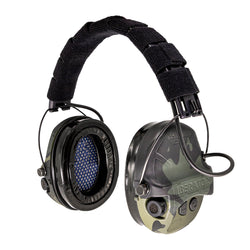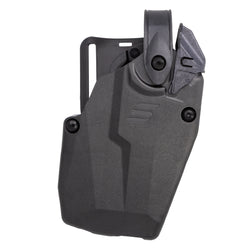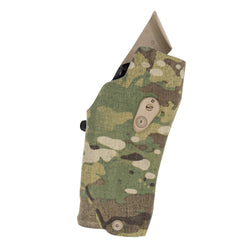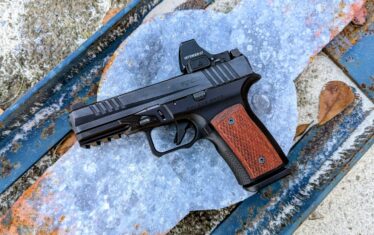Vortex is an undisputed leader in the optics space and a staple in the industry. The name itself has become synonymous with quality and earnestness. And yet, they’re one of the largest optics manufacturers in the country and have long had a healthy following of die-hard loyalists. Myself included.
They’re doing something right. Well, a lot right, actually.
I was lucky enough to be invited to accompany a small crew of a few of my fellow writers to spend a day at the Vortex headquarters in Barneveld, Wisconsin. I’m glad I went.
While I’ve been in the industry for a long while, I’m a firm believer that there’s always more to learn. That’s especially true in our industry, where technology is rapidly changing and there are quite literally millions of different shooting techniques, teaching styles, and individual setups.
So I showed up with an open mind, a half-charged iPad, and the full intention of shutting up and soaking it in. And it paid off.
I listened more than I talked, and what questions I had written down… well, let’s just say they were quickly replaced with better ones.
I walked away from just a single day with Reuben and Nick at Vortex with more insight than I ever expected, and definitely more than I could’ve prepped for. In the best way possible.
That said, grab a coffee. This is gonna take a while.
The Idea Behind the Trip
Our little crew’s a tight-knit bunch. We’re all good friends—nerdy misfits, really—who somehow ended up on your screen talking about guns, gear, and the great outdoors (appreciate you being here, by the way).
We’re always chasing ways to dig deeper into the firearms and outdoor industries. Not just to stay sharp, but to write from a place of authenticity. I guess you can just call it honest curiosity and the kind of humility that comes from knowing there’s always more to learn.
And yeah, we just genuinely like hanging out together.
So when Vortex Optics extended the invite to visit their HQ in Wisconsin, it didn’t take much convincing.
A road trip with good friends, a chance to learn from some of the best in the game, and an inside look at one of the most respected optics companies out there? Twist my arm.
Bags packed. Minivan loaded. Northbound.
We packed in like sardines, shared ideas, and even did a little writing from the road. Dremamine for the win.
Arriving at the Vortex Facility
After some eight hours on the road and about ten pit stops along the way (our bladders aren’t as strong as they used to be, okay?), we finally made it to the hotel in Barneveld; the sprawling Vortex facility only about 500 yards and one corn field away.
Already, I was in awe. It was bigger than I’d imagined, for some reason.
The next morning, we piled into the minivan with our notepads at the ready and made the two-minute jaunt from the hotel to the Vortex facility. It wasn’t exactly a dramatic journey, but the anticipation was real.

To call it elegant would be an understatement.
The exterior was modern and clean, lined with tall glass windows that reflected the morning sky. Neatly arranged native flowerbeds, still sprinkled with the morning dew, sprawled around the simple Vortex sign.
And the views. Oh, the views. Rolling hills, open skies, and that uniquely Midwestern calmness. Wisconsin is a beautiful state.
Immediately upon entering the building through the main doors and into the publicly accessible showroom, we were greeted by one of the kindest receptionists I think I’ve ever met. She smiled warmly and ushered us in with a hearty Wisconsin “Hello.”
It was the kind of hello that makes you feel all warm and fuzzy inside… Like you just walked into a good friend’s home rather than a multimillion-dollar operation.
And in that moment, I started to get it. The loyalty. The community. The reason people ride or die for the Vortex brand. It’s the culture; the Vortex ethos.
The Vortex Ethos
Vortex’s ethos is centered around three main pillars: People, Products, and Promises. And holy Billy, do they stand by it.
It’s ingrained in the very spirit of every employee. And they’re proud of it.
People First
After spending even just a few minutes with Reuben, Nick, and Shamus, I quickly realized something: “Vortex Nation” isn’t just some company moniker. It’s a living, breathing community. A real damn thing. And suddenly, I’m a part of it… Gladly so.
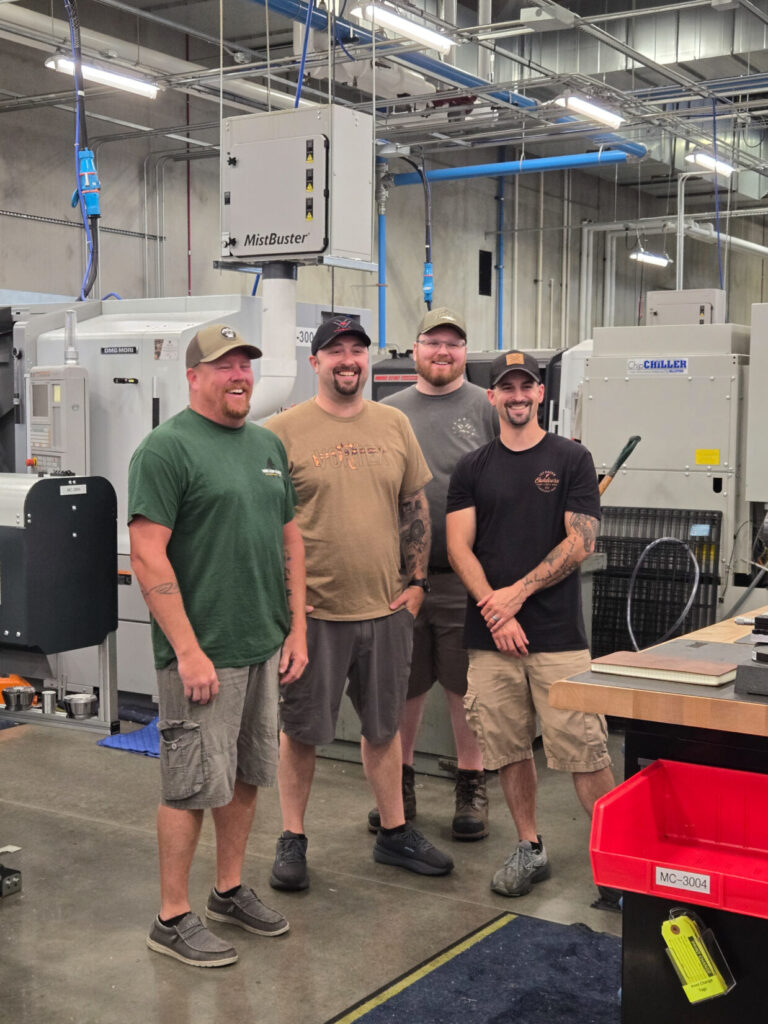
Everyone I met, from the machinists and sales managers to the customer service crew and front desk staff, carried themselves with an infectious pride. You know how some companies slap some gimmicky “people first” slogan on the wall and wear it like a self-awarded badge of honor? Yeah, that’s not the case here. At Vortex, it’s real. It’s lived.
And it’s obvious.
They don’t just care about their employees; they invest in them. You can feel it in the way people talk about their roles, the respect they have for one another, and the fact that everyone’s genuinely pumped to be there. We should all be so lucky, am I right?
A Part of Something Bigger
It isn’t a “Do your eight and head for the gate” kind of place. Instead, it’s a place where people are all-in, every day, because they know they’re part of something bigger.
And that mentality spills right over into how they treat their customers. At Vortex, the customer isn’t another transaction, some sales metric, or commission-earning quota.
It’s all about the human connection. You walk into that facility, and you’re not just another face. You’re seen. You’re welcome. You’re part of it. I was a part of it. Me. If even for a moment.
That’s humbling.
It’s people, followed by quality craftsmanship. Everything else is tertiary.
Optics. So Many Optics.
Now that I’ve practically drooled over how great the Vortex crew is, I suppose we should probably get down to the nitty-gritty. The meat and potatoes.
Optics.
So. Many. Optics.
Even though I’ve been in the game for a while, I guess I never really stopped to think about optics on a grander scale. I mean, we’re all fairly accustomed to seeing glass cases lined with dozens of red dots, rifle scopes, spotting scopes, binoculars, and the like.
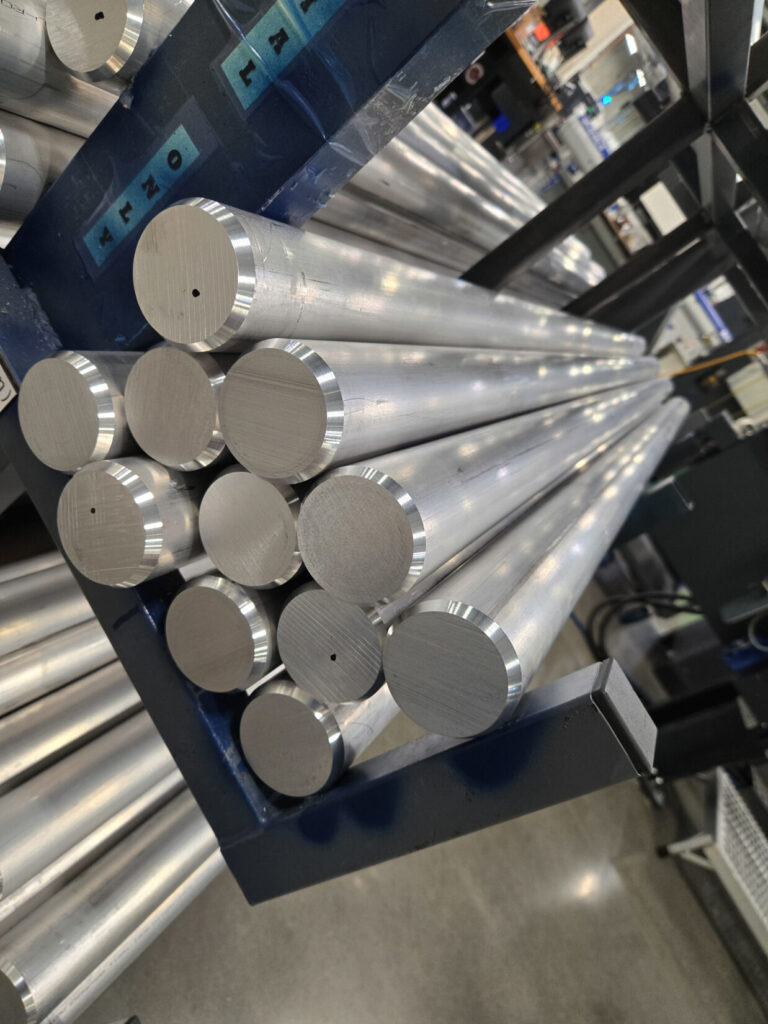
But it’s the lesser-known manufacturing processes and intricacies, I think, that we take for granted.
Specifically, I’ve never really taken the time to think about glass composition and the engineering that goes into it. Nor had I really considered just how tight manufacturing tolerances were or what that even meant.
I knew I cared about it. We all do. But for many of us, that concern only goes as far as asking, “Does it hold zero?” and “Is the glass clear?” Beyond that, we leave the hard math and technical wizardry to the big boys.
Well, we used to. Not anymore. Nick and Reuben saw to that.
Variables Galore: Maintaining Quality Standards
The first thing I learned is that manufacturing optics is essentially an exercise in controlled obsession. Every step, from sourcing raw materials to final assembly, is governed by a host of variables that are closely monitored and maintained.
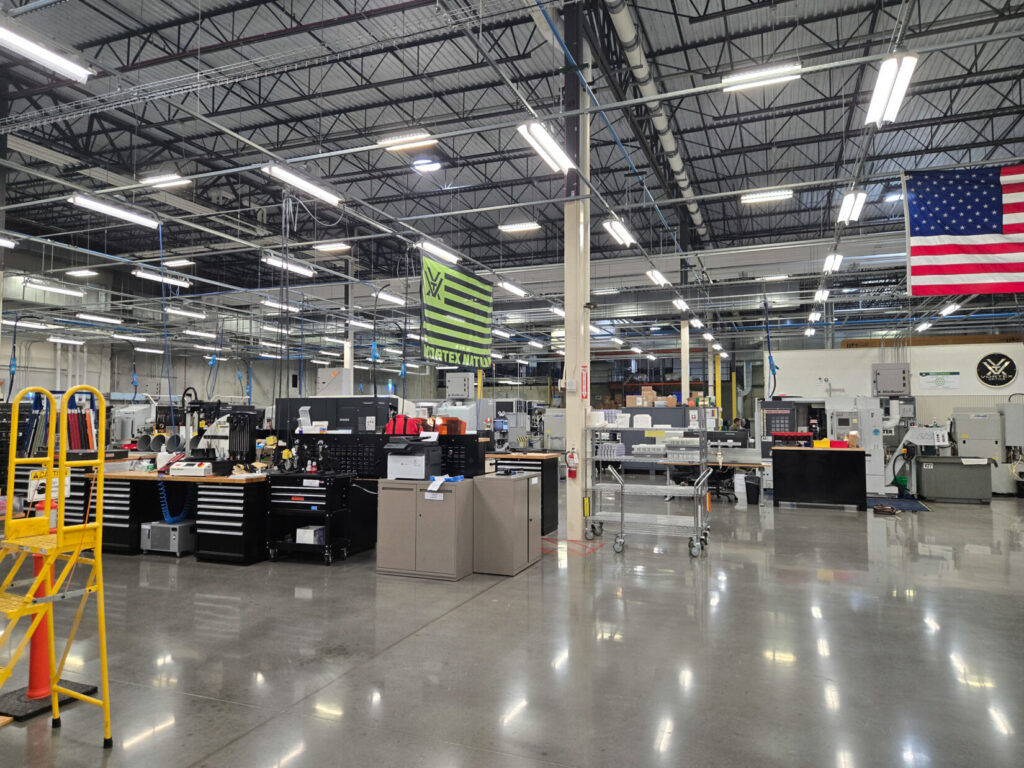
Even tiny changes in environmental conditions, like humidity or temperature, can affect how coatings bond to glass or how certain materials behave during the machining process.
Every machine in their facility is ultra-precise, monitored, and recalibrated regularly.
We call that Quality Control.
We’re not talking “close enough” either; this is precision down to microns. Fractions of a micron, actually.
And this doesn’t just apply to the high-end stuff. Whether it’s a basic Crossfire red dot or a $4,000 Razor HD Gen III, everything that rolls off the manufacturing floor—and I mean everything—is machined and inspected for excellence.
Vortex isn’t interested in maintaining the status quo or settling for acceptable quality. And it friggin’ shows.
Glass & Material Composition
The glass element is particularly fascinating. Well, to me, anyway.
If you’ve ever wondered why one scope has glass that looks crisp and color-true, while another seems like you’re looking through a dank and dirty fishbowl, complete with a crooked reticle, it comes down to materials and coatings.
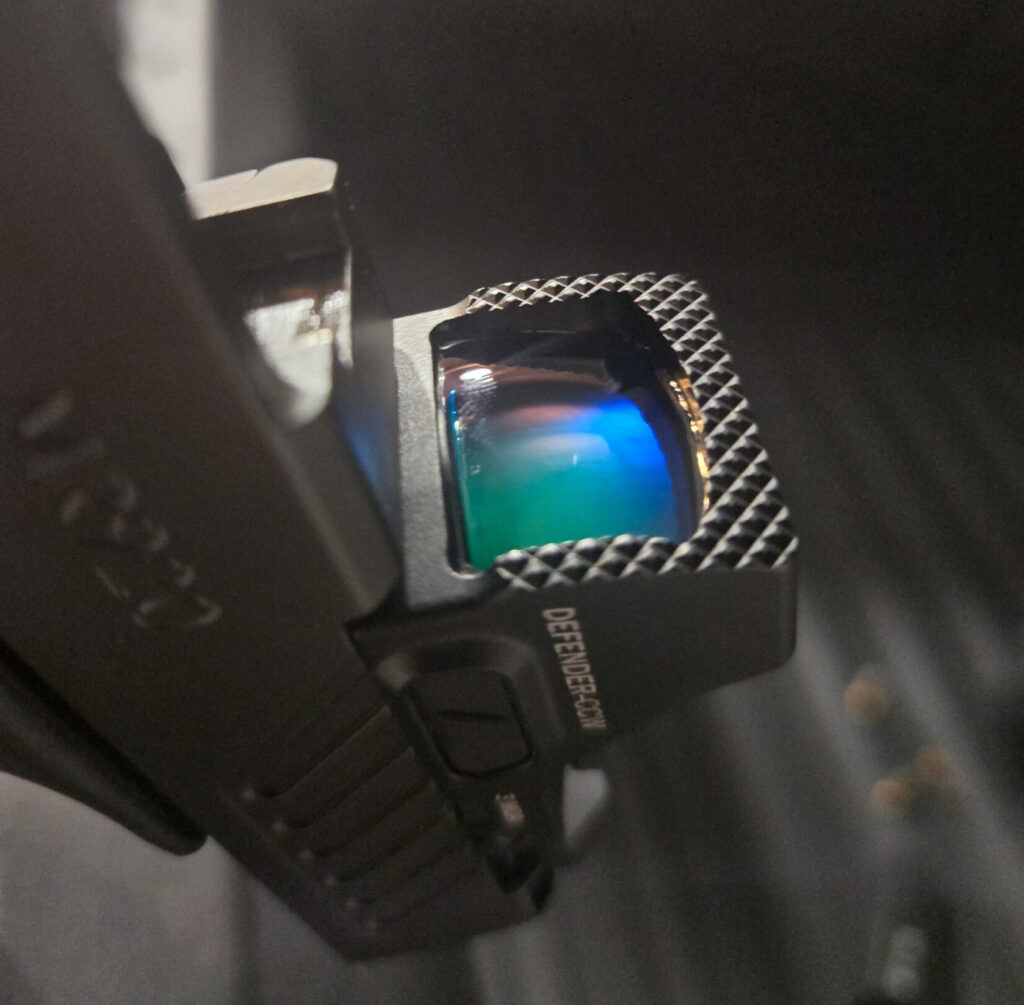
Vortex sources high-quality optical glass from trusted suppliers, but it’s not just about the purity of the glass. It’s also about how that glass is shaped, polished, and treated.
Multi-layer coatings are applied to manage light transmission, reduce glare, and enhance contrast, all while adhering to ultra-tight engineering specs. Again, you’re looking at microscopic tolerances.
Different models use different grades and types of glass based on the optic’s purpose. So, while your spotting scope is going to have one set of specs with a unique glass recipe and mixture of lens coatings, your StrikeEagle rifle scope is going to have an entirely different composition.
Shoot, even two products of the same family, but with a different purpose, might use two different glass recipes from two different suppliers.
It’s a science. And an art.
The Finer details
But there’s so much more to these optics (obviously) than the lenses. They’re assemblies of tiny, interdependent components, all of which depend on one another to deliver the clean, consistent performance we need.
Take something as seemingly mundane as the turret system, for example. The amount of engineering and quality control involved just to make sure that click feels the same every time is insane. Mind-blowing.
And it’s intentional. The fellas walked us through a bin of turret components, all machined in-house, each undergoing rounds of close, intense inspection.
Even the screws have to meet specific torque specs; not too much, not too little. Just right. Because if one screw backs out, the whole optic could shift under recoil. Ask me how I know.
No one wants that.
The point I’m getting at here is that nothing—from tube construction to thread tolerances tighter than one-one-thousandth of an inch on a screw the size of a gnat—nothing is done half-assed.
Precision. Accuracy. Attention to detail. Them boys mean business.
Prototyping and Redesigns
But the buck doesn’t stop there.
To think Vortex just designs a new optic, builds it once, and ships it out, would be living in a fantasy world.
Every optic goes through multiple rounds of prototyping, testing, and redesign before it ever makes it to the customer.
Some prototypes go straight to testing. Others end up in the hands of trusted shooters, who beat them up and ride them harder than an airport rental car, and send feedback.
Sometimes, that feedback results in a minor engineering tweak. Other times, it might be a “back to the drawing board” kind of moment.
Reuben mentioned one prototype that looked perfect on paper but never made it past the testing phase. Rather than slap a disclaimer on the box or take a gamble with recalls or an influx of returns, they scrapped the design and re-engineered it from start to finish.
That kind of humility and commitment to doing it right is what separates a good company from a great one.
Testing Procedures
Speaking of quality control and performance tests, the abuse that these optics are subjected to is not for the faint of heart. There’s a reason Vortex optics (or any quality optic, for that matter) can survive a fall, a flood, and the rigor of combat without failure. They test for that kind of stuff.

Every model, from those entry-level optics to $1,000+ models, undergoes impact, vibration, water intrusion, thermal cycling, and optical alignment testing.
One machine even simulates heavy recoil impulse. Not once, but hundreds of times. Because if your optic can’t handle recoil, well, it’s just a fancy, over-priced hunk of metal and glass.
Trash, I think, is the preferred terminology.
And yes, they destroy a lot of prototypes in the process. On purpose. So yours won’t fail or break when you need it.
Optic Reticle Types & Designs
Now let’s talk reticles. There’s plenty to discuss, that’s for sure.
You might think a reticle is nothing more than a preference; BDC, MOA, MRAD, whatever. After all, there’s no shortage of reticle options out there. But each design is as much about physics and user intent as it is about preference.
Nick broke it down for me during the range portion of our trip, discussing everything from clean duplex styles to complex holdover grids.
But for simplicity, we’ll just cover the basics here.
First Focal Plane (FFP) vs. Second Focal Plane (SFP) Reticles
In an FFP scope, the reticle changes size as you zoom in or out. At low magnification, it looks small and thin. And at higher magnifications, the reticle gets bigger and more detailed. The big advantage here is that your holdovers (the hash marks or dots that accommodate for elevation and wind) stay consistent across all magnification settings.
If you’re shooting at variable distances and actually using those hold points, FFP can be a game-changer. The downside, however, is that the reticle can become very small and difficult to see at lower magnification levels. This is especially true in low-light environments or against high-contrast backgrounds.
SFP scopes, on the other hand, keep the reticle the same size no matter the magnification. The upside is that the reticle is always easy to see, especially at lower magnifications, and often a bit less cluttered.
The trade-off is that holdovers are only accurate at one specific magnification, usually the highest. If you’re shooting at different ranges without adjusting your turrets, you’ll need to either memorize some offset values or do a little math on the fly.
For someone like me, where math was never exactly my strongest subject in school, it’s something to be aware of.
That said, the debate between whether an FFP or SFP-style reticle is the better option really depends on you, your preferences, and your specific shooting application.
Personally, while I own and have used both designs, I’ll likely choose an optic with a first focal plane reticle over one with a second focal plane design. I might be wrong for it, but it’s just a preference at this point.
Common Reticle Types: A Quick Breakdown
Once you’ve figured out whether you’re going with a first or second focal plane scope, the next step is choosing a reticle that aligns with your shooting preferences and specific shooting applications. Some reticles are built for speed, others for precision, and some try to strike a balance between the two.
There are tons of options out there, but again, for simplicity’s sake, I’ll break down some of the more common styles you’re likely to run into and what they’re best used for.
Duplex Reticle
Duplex reticles are a classic. They’re simple, no-nonsense, and work for just about any general-purpose shooting. They offer bold, thick outer crosshairs that taper down to a fine center point. That makes it easy to center your target quickly while keeping the view uncluttered, especially handy when you’re hunting in thick brush or low light.
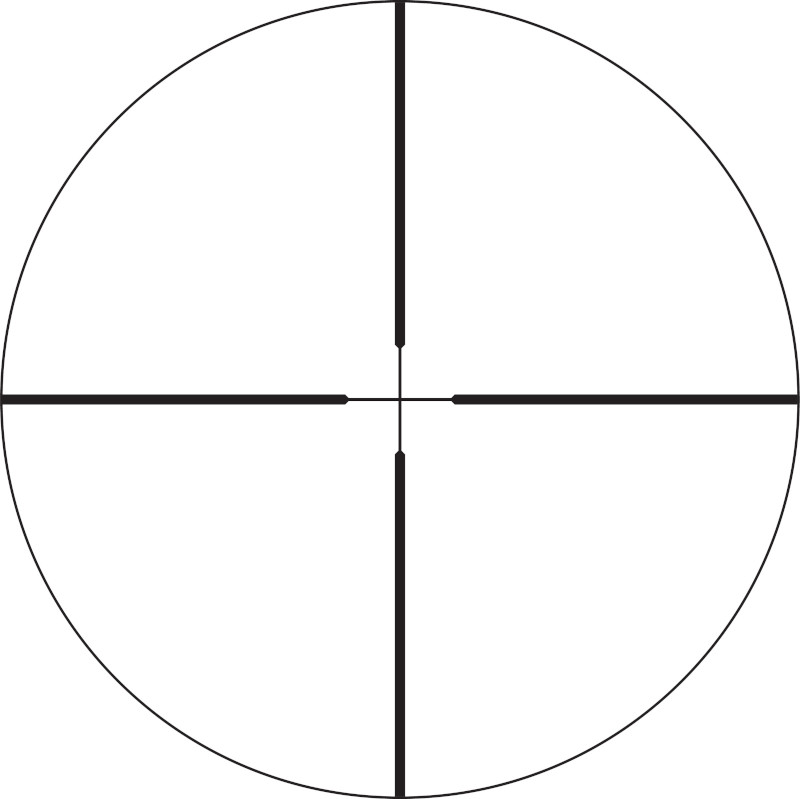
It’s not meant for holdovers or complex ranging, but for fast, accurate shots at reasonable distances.
Mil-Dot and MOA Reticles
If you’re doing long-range shooting, mil-dot and MOA-based reticles are your bread and butter. These reticles are marked with evenly spaced dots (mils) or hash marks (MOA) along the horizontal and vertical axes. They’re used for estimating range, compensating for bullet drop, and holding for wind.
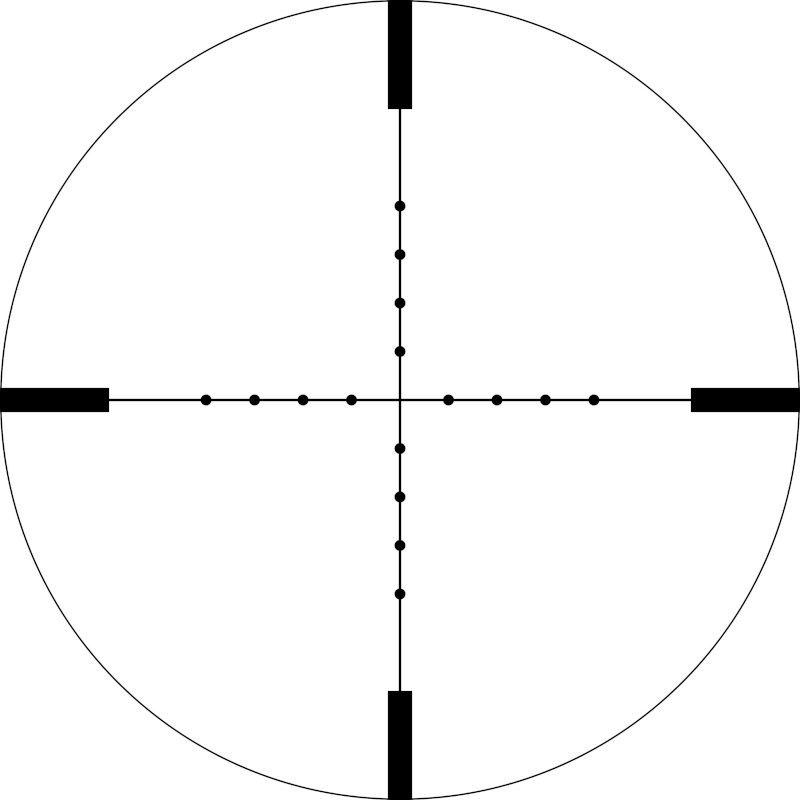
It takes a little time to learn how to use them properly, but once you do, they give you a lot of flexibility. Whether you’re ringing steel at 800 yards or making a first-round hit on a coyote at an unknown distance, these reticles let you work the math and make it happen.
BDC (Bullet Drop Compensator) Reticles
BDC reticles are designed to take some of the guesswork out of longer shots. They come with pre-calculated holdover points based on specific calibers and loads, like .223 or .308, and are usually marked for common distances (100, 200, 300 yards, and so on).
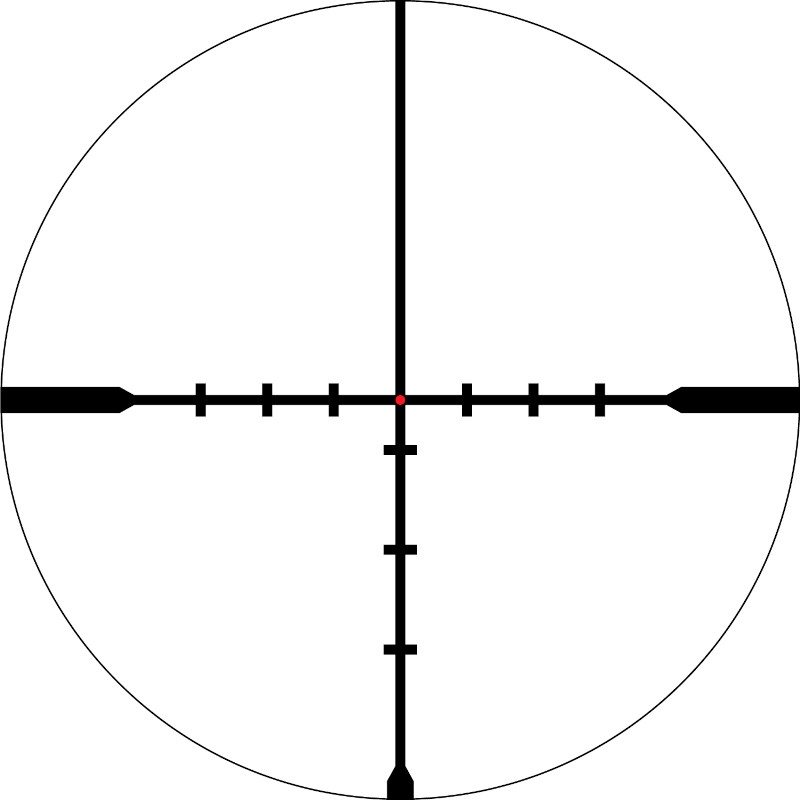
From my understanding, however, BDC reticles are only truly accurate when your rifle setup matches the conditions they were designed for. That is to say that barrel length, bullet weight, and velocity all matter in terms of actual performance. Something to think about.
Tree-Style Reticles
Christmas tree-style reticles go even deeper. These offer a grid of elevation and windage markings below the center point, allowing you to make fast, precise holds for distance, wind, and even moving targets without ever touching your turrets.
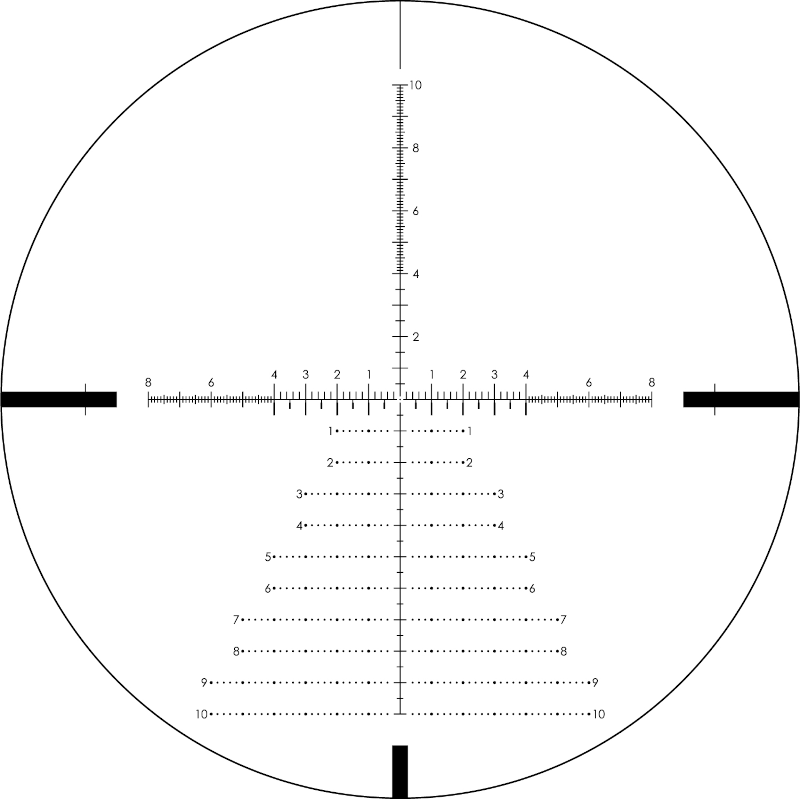
They look busy, but if you know how to use them, they’re one of the most powerful tools a precision shooter can have.
In Summation
Every hash mark has a purpose. Every line is a calculation. The more intricate the design, the faster your calculations and the more accurate and repeatable your shots are.
It was a much-needed refresher in basic physics and ballistic performance.
Not All Created Equal
From the outside, a scope is a scope. Am I right?
But there’s so much more to them than I ever thought imaginable. Each model is a perfect balance of precision engineering, tightly controlled manufacturing processes, and no small amount of obsessive nerd energy.
That said, not all optics are created equal. Engineering matters as much as quality control. Forfeit either in return for a lower cost and higher profit margin translates to a reputation similar to something from Wish.com.
Vortex, though, has struck the perfect balance of quality and affordability.
No small feat, indeed. But it kind of goes back to that “customer first” mindset, I suppose.
Anyway, I came away from my Vortex visit with a deeper appreciation for the optics I’ve relied on for years. These aren’t just chunks of glass and aluminum. They’re purpose-built tools crafted by people who genuinely give a damn.
And now that I’ve seen the inside, I’ll never look at an optic the same way again.
Old Favorites: Time-Tested Scopes & Red Dot Sights
Like you, I have several old favorites; time-tested optics that I’ve been using for years. Ones that have seen more range trips, rough handling, and field time than you can possibly keep track of. They’re the old faithfuls. The trusted, maybe even sentimental pieces.
Not surprisingly, a good chunk of my most trusted optics bear the Vortex name. Not all of them. But enough that it says something. Vortex has earned its spot in my rotation by delivering consistently solid performance, year after year, across different platforms and different applications.
Out of everything I’ve run over the years, there are three specific models that I keep coming back to. Models that I think belong in every gun safe for one reason or another.
Let’s break ’em down.
Vortex Diamondback Tactical 4-16×44 Rifle scope
The Vortex Diamondback Tactical 4-16×44 rifle scope has been my go-to workhorse for several years running. Currently mounted on my Savage 110 Tactical bolt gun in .308 Winchester, it’s really the perfect balance between affordability and real-world performance. The glass is surprisingly clear for the price, and the exposed tactical turrets consistently track true.
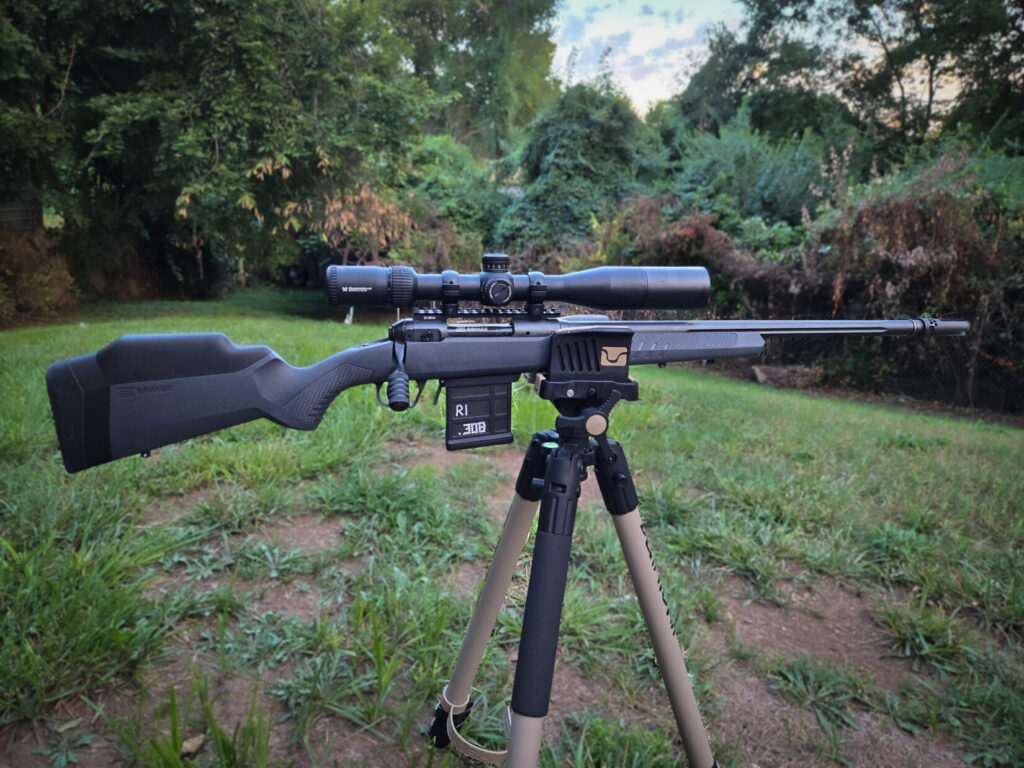
I’ve run this scope on everything from bolt guns to semi-autos (not really my favorite setup, but it works), and it holds zero like a champ. The first focal plane (FFP) reticle is a huge win, especially if you’re doing any kind of distance shooting where your holdovers matter.
I’m no marksman just yet, mind you. But even as a total noob to the long-range game, it’s proven entirely effective.
It’s built like a tank, too, taking its fair share of bumps and hard knocks, and still holding strong. So aside from one or two dings here and there, it’s in perfect shape. And as with any Vortex scope, I’d expect nothing less.
If you’re looking for a solid entry into precision shooting or just want a dependable optic that won’t blow your budget, this one’s more than earned its keep.
Vortex Crossfire II Scout Rifle Scope
For anyone running a scout-style setup or just looking for a low-profile, no-BS scope, the Crossfire II Scout is hard to beat. Nuff said.
It’s perfect for lever guns, scout rifles, or any setup where you need long eye relief without compromising on capability. I’ve got mine mounted on my M1A Scout Squad, and while the gun is incredibly accurate with standard iron sights, the Crossfire II really takes the scout shooting experience to a whole new level.
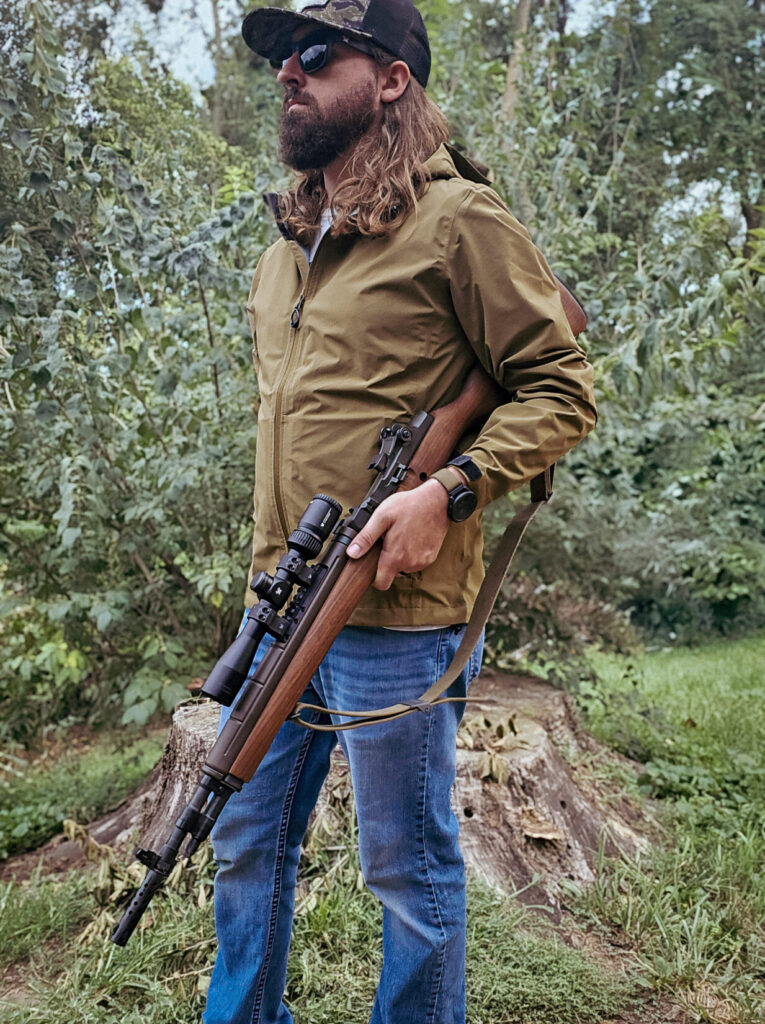
The 2-7x magnification range easily takes you out beyond 75 yards without overcomplicating things, and the generous eye relief makes it fast and forgiving. That’s a big deal when moving and transitioning between close-range targets and those at extended ranges.
The glass is nothing fancy, but it’s clear enough. Like I said, it’s a no-frills, performance-built scope. It does what you need it to, when you need it to. Nothing more, nothing less. And with a price tag of around $200, that’s good enough for me.
Vortex Sparc II Red Dot Sight
The Sparc II has lived on everything from ARs to PCCs—including its current home atop my Beretta CX4 Storm—and it’s still ticking right along. It is compact, reliable, and insanely user-friendly.
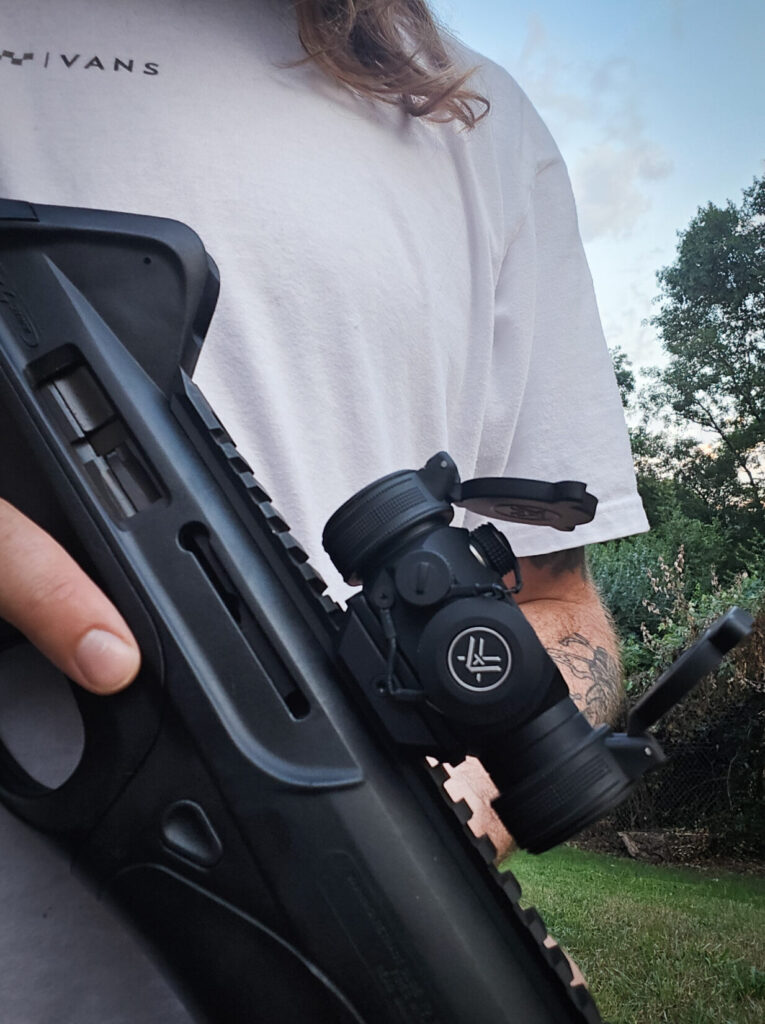
There’s nothing to it, really. Well, on the surface, at least.
Just a clean, crisp dot and simple push-button brightness controls. Just how I like it.
Battery life is solid, and the controls are intuitive enough to use even with my Safariland combat gloves on. I’ve never had so much as a flickering dot or loose lens cap with mine. And believe me, it’s been through the wringer… including a few drops from the tailgate of my truck.
Even if I did have an issue, though, remember that every Vortex optic is backed by that wicked-cool VIP lifetime warranty.
They’d take care of any problem you might run into, no sweat.
So, if you’re looking for a lightweight red dot that’s relatively compact and won’t quit on you when it counts, get yourself a Sparc II. It’s a no-brainer, really. Especially at its sub-$300 price point.
A Greater Respect for Optics Manufacturers
Our little jaunt up north to the Vortex HQ gave me a renewed appreciation for optics manufacturers.
Seeing the behind-the-scenes process firsthand, from initial design all the way through to quality control and testing, drove home how much thought, expertise, and sheer dedication go into every optic.
It’s easy to take a scope or red dot for granted when all you see is the finished product mounted on your rifle, doing what it’s supposed to do. But visiting Vortex pulled the curtain back in a way that had me rethinking my entire attitude toward optics.
And for good reason.
There’s a staggering amount of design, testing, and downright obsessive attention to detail that happens long before that optic ever makes it into your hands. And once you see it all in person, you stop looking at optics as just another accessory and start appreciating them as a piece of engineering genius.
After walking those factory floors and shaking hands with the folks who make it all happen, I walked away with more than just technical knowledge. I walked away with a deeper respect for the craft, the commitment, and the community that makes it all possible.
And this isn’t the last time you’ll hear from me preach about Vortex. That’s for sure.
In short, Vortex is the real deal. From the people to the products, it’s a company that’s more than earned its spot in the market. If you haven’t already, it’s high time you add a few Vortex optics to your safe.
You can thank me later.


